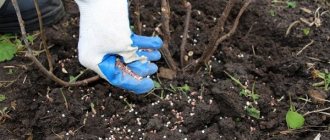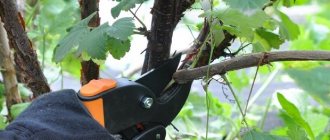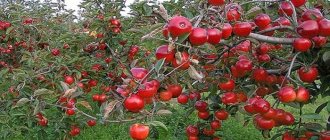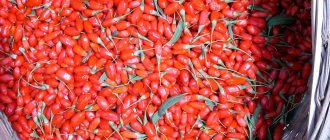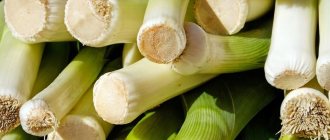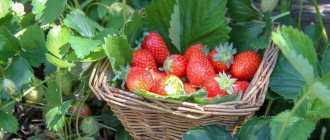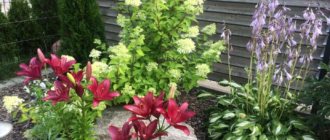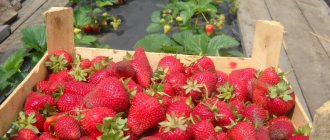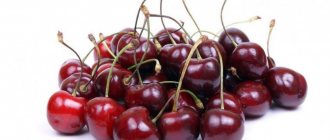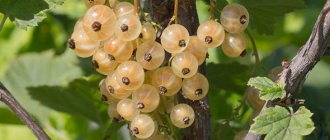Author: Natalya Category: Fruit and berry plants Published: January 29, 2019Republished: February 26, 2019Last edits: November 14, 2020
- What to feed
- When to prune
- How to treat strawberries against diseases
Strawberry is the common name for the plant and berries of the nutmeg strawberry (Latin Fragaria moschata = Fragaria elatior) , which became widespread in the 20th century. The word “strawberry” itself is derived from the old Russian “club”, which in ancient times meant something round, spherical. Musk strawberry, also known as muscat strawberry, also known as tall strawberry or Spanish strawberry, or sometimes just spanberry, also known as tall strawberry, garden strawberry, real strawberry, European strawberry, is a herbaceous perennial of the genus Strawberry of the Rosaceae family. Strawberries are often called garden strawberries , or large-fruited , or pineapple strawberries (lat. Fragaria × ananassa) - well, in different decades, either muscat strawberries or pineapple strawberries were massively cultivated in gardens - both were called strawberries or “victoria” (according to name of a popular variety). Nowadays, nutmeg strawberries are most often grown, which means that now they are strawberries. This berry has been known to mankind since antiquity - references to it have been found in Egyptian and Greek written documents, and even in Virgil. Nowadays, this berry is mostly cultivated in Europe and the Americas.
Botanical description
Strawberry is a herbaceous perennial plant, the bushes of which reach a height of 15-35 cm. The stems of strawberries are erect, covered with glandular hair. Strawberry leaves are trifoliate, large, light green in color. Strawberry blossoms look attractive - white five-petal flowers with a double perianth are collected in corymbose inflorescences of 5-12 pieces. The so-called strawberry is actually an overgrown receptacle with numerous small fruits and nuts located on its surface. Strawberries have a sweet and sour taste and a pleasant aroma.
Strawberry fruiting time
The flowering and fruiting of strawberries does not have clear time limits - each variety has its own. In varieties with one-time fruiting, the active period is very short. Early varieties begin to bear fruit in May. Some of the earliest varieties, Alba and Lambada, bear fruit from the second decade of May to the beginning of June, a little later the fruits of the Darselect and Hani varieties ripen, followed by Korona, Eliani, Polka, Elsanta, each with a shift of 3-4 days. All these varieties begin to bear fruit in May, but there are later varieties - June and July: strawberries in June are the varieties Symphony, Florence, Victoriani, and strawberries in July are Malvina.
Remontant varieties, or day-neutral varieties, which vegetate almost until frost and bear fruit several times during this period, also differ in terms of fruiting, but such strawberries begin to ripen in the summer. For example, harvesting of Portola strawberries begins only in August and lasts until mid-November, Flamenco varieties - from mid-August to mid-December, and varieties such as Albion, Marling Pearl and Opal Pearl bear fruit from July to December.
- Raspberries: autumn planting and care, pruning
Next, we will tell you how to care for strawberries from the moment they stop bearing fruit until the time when all life in the garden ceases altogether - how to water the strawberries, when and what to feed them, whether they need to be pruned and how to do it.
Caring for strawberries after harvest
Watering
Growing strawberries does not end the moment berries stop appearing on the bushes. Even after the harvest is harvested, strawberry care continues. After all, strawberries do not stop growing and developing after harvesting, so one of the most important points in caring for them is moistening the soil on the site.
How often should you water strawberries so that they can recover, get stronger and grow bud buds for the next harvest? You need to water infrequently, about once a week or a decade, but generously so that the soil is saturated with moisture more deeply - surface watering will not bring any benefit.
Weeding strawberries
After watering, it is necessary to loosen the soil in the area to a depth of 10 cm, but near the bushes, use the hoe more carefully - do not damage the root system. While loosening, hill up the strawberry bushes, sprinkling soil on the growing adventitious roots.
At the same time as loosening, remove emerging weeds. Make sure that the strawberry beds are not overgrown with grass. Remove weeds between the rows, and then pour all kinds of small debris into the aisles cleared of grass - sawdust, dry branches, wood chips, etc. This measure will prevent the area with strawberries from becoming overgrown with weeds. Later, in the fall, you will have to weed the weeds again, but there will be significantly fewer of them if you do the main work of destroying them in the summer, immediately after picking the berries.
Trimming tendrils and leaves
The leaves and tendrils of strawberry or Victoria are that part of the plant that continues to actively develop after harvesting, when future flower buds are also actively being formed, and nutrients accumulate in the stems. Experienced gardeners know that in summer and autumn, garden strawberries need to be cared for by timely pruning of the above-ground parts of the plant.
Removing tendrils and leaves
Strawberries can reproduce by seed or vegetative methods. In the latter case, rooting occurs with the help of long processes called mustaches. Sometimes the mother bush produces them in huge quantities. Therefore, young shoots must be thinned out regularly. For breeding, the healthiest and strongest tendrils, well developed, are left to form independent plants. They are cut from the mother bush and rooted in a new area.
The rest of the mustache is cut off. Failure to prune weakens the mother plant. Overgrown mustaches take moisture and nutrients for their development. In addition, there is a gradual thickening of the bed. As a result, the size and number of berries decrease, creating favorable conditions for the development of diseases.
Remove the mustache with a sharp garden tool, allowing you to make a cut close to the surface of the soil. A garden knife is best suited for this purpose. With its help, shoots are cut off at soil level.
Important!
You cannot pull out your mustache with your hands. This leads to a violation of the integrity of the root system. Partial loss of roots increases the risk of death of the entire bush.
If the age of the bushes exceeds 3 years, you can additionally mow the foliage. Mowing is carried out 3 days after the last fruits are collected. This procedure has the following advantages:
- improves yield for the next year;
- protects strawberry plantings from diseases and pest attacks.
How to prune strawberries correctly
You can remove leaves by combing them with a rake, mowing or cutting them with a garden knife or scissors. I strongly do not recommend picking off leaves: by pulling a leaf, you can pull out a bush or part of it, disturbing the root system. A damaged bush will take a long time to recover, become sick, and the harvest for the next season will decrease.
The best option for those who have small plots is to remove unnecessary leaf blades with sharp garden scissors or pruning shears. You can mow the leaves, but try not to damage the rosettes and healthy leaf mass.
Should I prune my strawberries too much?
Often inexperienced gardeners wonder whether it is necessary to prune shrubs after they bear fruit. There is a clear answer here - leaves are removed only if they are yellow, withered, or if there is a need to rejuvenate strawberry plantations. In the second case, it is worth removing the largest sheets possible. Also remove those parts of the bushes that are affected by pests or diseases.
Fertilizing strawberries
What to feed
Organic fertilizer for strawberries has proven itself to be excellent - horse manure, humus or mullein. Strawberries also respond well to the addition of chicken manure as a top dressing. You can also use more modern means - mineral fertilizers, for example, ammophoska, which contains nitrogen, phosphorus and potassium, as well as magnesium, sulfur and calcium. It is highly undesirable to apply chlorine-containing fertilizers, since strawberries do not tolerate chlorine well.
- Timely spring care of raspberries will bring a rich harvest
How to fertilize
Immediately after removing the weeds and loosening the soil, spread small pieces of mullein or horse manure over the area. All subsequent waterings and rains will gradually dissolve these substances, release microelements from them and deliver them deep into the soil, to the strawberry roots. But the method of fertilizing the area with chicken droppings works much faster. To do this, fresh droppings are diluted in a ratio of 1:20 in water, mixed thoroughly, and the mixture is poured under the strawberry bushes. The consumption is approximately this: one bucket for 8-10 strawberry bushes.
If you decide to use mineral fertilizers, scatter them over the garden bed, hoe them into the soil, and then water the area. To prevent a crust from forming on its surface after moistening the soil, mulch the area with strawberries with peat or pine needles. In the future, you can loosen the soil and water the strawberries through the mulch.
Fertilizing and loosening the soil
The soil between the rows of strawberries needs to be loosened to a depth of about 8-10 cm. Remember that the root system of the bush is located at a depth of only 5 cm. Therefore, it is better not to loosen the soil near the rosettes, but only slightly hill up around it so that new adventitious roots growing from the horns will - parts of the strawberry bush found themselves under a layer of soil.
After loosening the soil, you need to mulch it to solve several problems at once:
- create optimal soil moisture, because the soil under the mulch will be moist and soft for a long time; after rain it will not become crusty;
- save time and effort that is spent on weeding;
- berries that do not touch the ground, do not rot or get dirty;
- Mulch prevents slugs from damaging strawberries.
A good composition for mulching is straw, pine needles, large sawdust. It is better to mix sawdust with other materials so that their dense layer does not prevent air from penetrating to the roots of the plant. Mulch should be laid in layers of different heights - for sawdust up to 7 cm, and for straw and leaves - up to 15 cm. Winter covering of bushes is done in the rows, without covering the plants. As soon as the spring growth of garden strawberries begins, the mulch will need to be removed.
Feeding and loosening
After pruning the plants, loosen the soil. The soil is processed only between rows. Strawberries have a shallow root system. Therefore, when working with soil near bushes, the roots can easily be damaged. To protect adventitious roots, it is better to perform hilling. Then they will be under a layer of soil and will not freeze in winter.
To maintain soil fertility and enrich strawberry bushes with nutrients, fertilize with organic fertilizers and mineral complexes. For garden strawberries, the choice of fertilizer is based on the condition of the soil and the timing of application. The following options are possible:
- In July, after picking the berries, mineral complexes are added before pruning. For each square meter, use 20 g of ammonium nitrate and chlorine-free potassium sulfate, and 40 g of superphosphate. Then carry out abundant watering. For adherents of organic farming, nettle infusion can be used instead of these fertilizers.
- Having completed pruning, the bushes are fed with a solution prepared from 10 liters of water, 1 cup of wood ash and 30 g of nitroammophoska.
- At the end of July, the beds are watered with an infusion of bird droppings. The working solution is prepared by diluting 1 part of the concentrate with 15 parts of water.
- At the end of August, organic feeding is repeated, but mullein is used as the main component. It is mixed with water in a ratio of 1:10. When adding fertilizer, pour the liquid under the root, trying not to get on the leaves.
Important!
When fertilizing strawberries, you should not use preparations containing chlorine.
Loosening and hilling
Loosening improves air permeability to the roots, reduces moisture loss, and helps get rid of many weeds. Usually the procedure is carried out 2 times a month. If there is a black film spread around the bushes, then loosening is not carried out. Loosen the row spacing with a shovel shallowly so as not to damage the roots and new bushes. You can use hoes, scoops, hoes.
Strawberry roots often come to the surface of the soil; if hilling is not carried out, then rain, wind, and heat can damage the rhizome. Nutrition will deteriorate, there will be few fruits. Make a small mound around the bush, leaving a rosette on the surface, and water it.
Attention!
If weed removal is delayed until autumn, the weeds will deplete the soil and the strawberries will be left without food for the winter.
Fertilizing strawberries after fruiting
After pruning the strawberries in July, they need to be fed so that the plants become stronger and overwinter well. Suitable for this purpose is spraying the leaves with a dark pink solution of potassium permanganate, watering with an infusion of wood ash, or using a complex mineral fertilizer.
How to fertilize strawberries
Dry mineral fertilizers for strawberries must be applied in a certain order:
- loosen the soil
- water – a bucket of water per 1 m²,
- sprinkle fertilizer over the surface,
- sprinkle dry soil on top.
Also, dry mineral fertilizers can be dissolved in water (0.5 tbsp per 1 liter of water) and watered with them on the soil under the earthen bushes, spending 2-3 liters per 1 m² of soil.
Attention!
Fertilizers containing chlorine, such as potassium chloride, should not be applied to garden strawberries. Strawberries react very poorly to chlorine: growth may slow down or fruiting may deteriorate.
| ADVICE Pay attention to the water-soluble complex mineral fertilizer Monopotassium phosphate from Buyskiye Fertilizers. Monopotassium phosphate is included in the nutritional system for strawberries (strawberries). Dose of the drug for fruit and berry crops: 10-15 g/10 l of water, solution consumption is the usual watering rate. Time, application features: 1st feeding – after flowering 2nd feeding - 15-20 days after the first 3rd feeding – mid-September |
Photo: Phosphorus-potassium water-soluble fertilizer Monopotassium phosphate for fertilizing fruits and other crops
What do you feed strawberries with?
It has been proven that during the growth and ripening of berries, strawberries spend a lot of micronutrients and substances. Therefore, after harvesting, the crop is weakened and requires special care. During this period, it is important to fully nourish it. You can feed strawberries after fruiting and pruning leaves with mineral and organic fertilizers. The most commonly used are:
Mullein infusion
- Mullein infusion. One of his fate is rushed with water in a ratio of 10 parts. The entire mixture is infused for 24 hours. Then some of the wood ash is added here. Mix everything and pour it under the root of each bush.
- Chicken droppings. It is placed under each bush and covered with soil.
- Urea. It is taken at the rate of 30 g for every 10 liters of water.
- Nitroammophoska. Here you need to mix 2 tablespoons of the product with a glass of wood ash and 10 liters of water.
Preparation of nettle infusion
- Nettle infusion. To do this, fill the bucket about a third with grass. Then pour boiling water over it. Infuse the product for about a week. Then the bushes are treated with it after the harvest is harvested. This feeding not only saturates the bushes with useful microelements, but also protects them from pests.
- You can also feed strawberries in the fall with universal organomineral fertilizers. “Kaury”, “Flumb”, “Elegy”, “For Strawberries”, “Shungit”, etc. are in good demand.
Advice: About two weeks after such fertilizing, you can fertilize the plants with products high in potassium and phosphorus. It is these microelements that provoke the formation of flower buds for future berries.
Wood ash
Preparing a solution from wood ash
Dissolve 2 cups of ash in 10 liters of water and leave to infuse for 1-2 days. The resulting volume of solution is enough to water 1-2 m² of bed. Fertilizing with wood ash saturates plants with calcium, potassium and phosphorus. In addition, it helps get rid of most insect pests.
Urea and ammonium nitrate
Ammonium nitrate packaging
Urea is a powerful source of nitrogen; it consists of almost 50% of this substance. As a rule, fertilizer is applied to the soil in dissolved form, but the spraying method can also be used. To prepare the solution, you need to take 1 tbsp. a spoonful of urea and dissolve it in 10 liters of water. One bush will need no more than 0.5 liters of product.
Ammonium nitrate has a lower nitrogen content. Its advantage is that it is absorbed immediately after feeding, whereas for urea this period is a week.
Bird droppings
Bird droppings solution
Many gardeners use ordinary chicken manure as fertilizer. To prepare a concentrated solution, you need to take a plastic container, fill it with droppings to the middle, then fill it with water to the top. The solution should ferment for about a week, after which the fertilizer is used to water the plants. The resulting concentrate is diluted with water (1:10). It is recommended to water the bushes 2 hours before feeding so that the roots do not get burned.
Cow dung
Mullein solution
Another effective organic fertilizer is obtained from cow manure. In a large barrel, mix 1 part manure with 5 parts water. Next, you need to tightly close the container, leaving the mixture to ferment for 14 days. After the expiration of time, the solution will lighten, heavy particles will settle to the bottom. For watering, use 1 liter of product diluted in 10 liters of water.
Strawberry pruning
When to prune
Do not put off pruning strawberries until the fall; do it immediately after the strawberries have stopped bearing fruit. As for remontant varieties, it is better not to prune bushes that bear fruit for the first year at all, removing only weak or diseased leaves and tendrils, if the variety you are growing produces them. Remontant strawberries are cultivated only for a year or two, then their yield decreases noticeably and the berries become smaller.
How to prune after harvest
Remove bushes from the area that will no longer bear fruit - in their place you can still have time to grow some later crop this year. From those bushes that will bear fruit next year, you need to cut off all the foliage at a height of 10 cm from the ground, and also remove the strawberry tendrils. Don’t worry that the strawberries are left without leaves after pruning – they will still have time to grow them before winter.
Detailed information about planting and caring for strawberries
How to prepare strawberries for winter
In late autumn, it is advisable to cover the bushes with spruce branches or additionally mulch them with pine needles or straw. Well-covered strawberries will not freeze and will delight you with a rich harvest in the new season.
Surely, there is no person who would be indifferent to these fragrant and sweet gifts of our summer. Strawberries and wild strawberries grow almost everywhere, in all the expanses of our homeland. This plant pleases us with its color almost the very first. It is quite unpretentious to grow. And how much both children and adults love her is beyond discussion!
Health to you and your loved ones! Natalya Belokopytova.
Strawberry processing - prevention
How to treat strawberries against diseases
In the fight to prevent strawberry diseases and pests from depriving you of your berry harvest, the best remedy is scrupulous compliance with the agrotechnical conditions for its cultivation, because strawberry diseases are a consequence of violating the rules of caring for it. However, there are times when strawberries get sick, even if you follow all the rules. To prevent this from happening, it is necessary to carry out preventive treatment of strawberries against diseases, and this should be done in the fall. It is best to spray the strawberries and the area with nitrophen - this drug will destroy all pathogenic viruses and fungi on the strawberries and in the soil.
If you notice signs of powdery mildew on strawberries, additionally treat the bushes with topaz.
Treatment and prevention of strawberry diseases and pests
How to treat pests
Strawberries suffer from strawberry mites, weevils, slugs and snails. Gastropods must be eliminated manually, and strawberries can be protected from other pests by preventative treatment of the area with Actellik or Karbofos - these drugs can cope with most parasites.
- Strawberries Elizabeth the Second: all about the royal variety
How to treat strawberries from pests and diseases
Have your plantings been attacked by pests in the summer? Or maybe you had to fight rot or insidious powdery mildew? After picking the berries, it is necessary to return to processing again, not forgetting about the prevention of healthy plants. To begin with, remove all diseased and affected leaves and shoots from the beds, and cut off suspicious bushes. Remove old mulch, as it most often harbors pathogenic fungi and some types of pests. Emergency treatment of strawberries involves the use of pesticides. To protect against pests (weevils, whiteflies, mites, ants) use:
- Karbofos;
- potassium permanganate (pink solution);
- iodine solution;
- baking soda;
- Inta-Vir.

